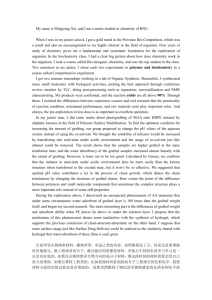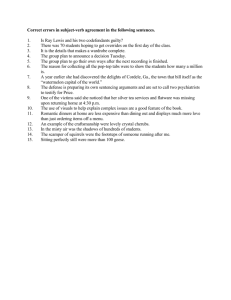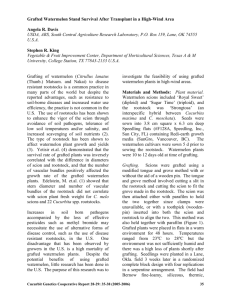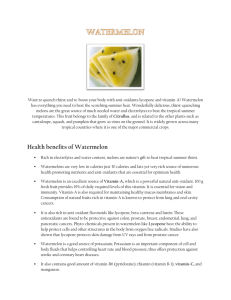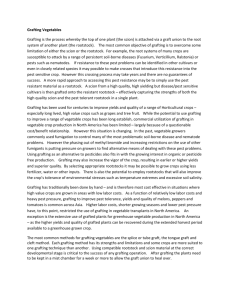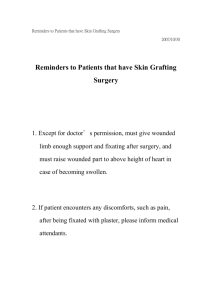Grafting Watermelon onto Pumpkin
advertisement
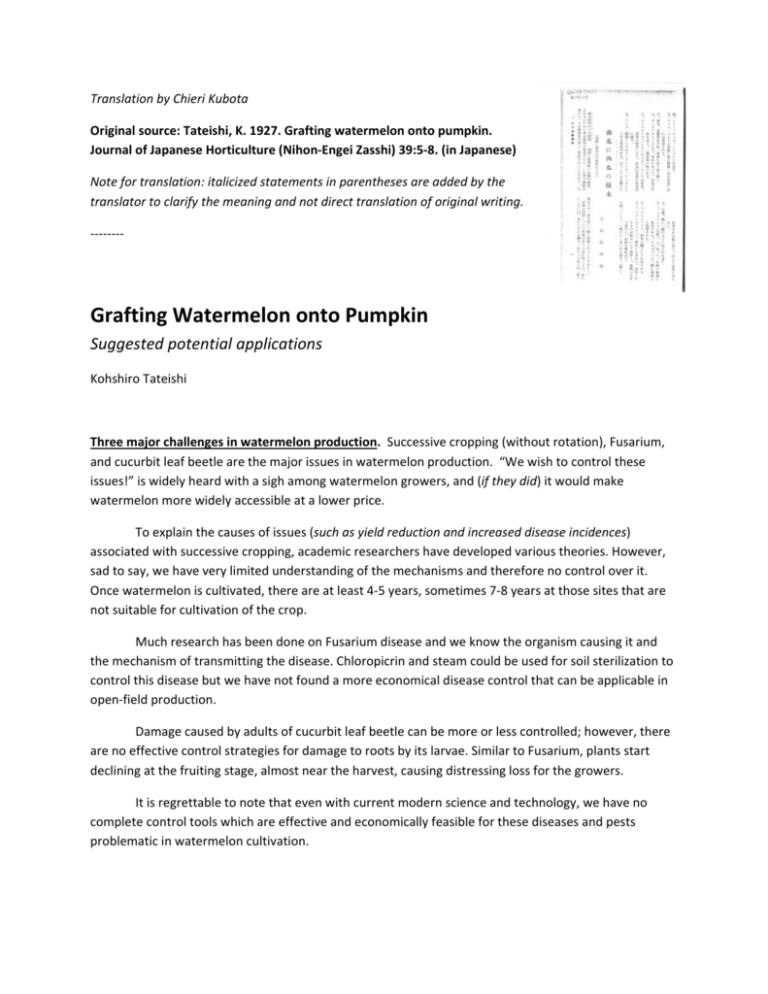
Translation by Chieri Kubota Original source: Tateishi, K. 1927. Grafting watermelon onto pumpkin. Journal of Japanese Horticulture (Nihon‐Engei Zasshi) 39:5‐8. (in Japanese) Note for translation: italicized statements in parentheses are added by the translator to clarify the meaning and not direct translation of original writing. ‐‐‐‐‐‐‐‐ Grafting Watermelon onto Pumpkin Suggested potential applications Kohshiro Tateishi Three major challenges in watermelon production. Successive cropping (without rotation), Fusarium, and cucurbit leaf beetle are the major issues in watermelon production. “We wish to control these issues!” is widely heard with a sigh among watermelon growers, and (if they did) it would make watermelon more widely accessible at a lower price. To explain the causes of issues (such as yield reduction and increased disease incidences) associated with successive cropping, academic researchers have developed various theories. However, sad to say, we have very limited understanding of the mechanisms and therefore no control over it. Once watermelon is cultivated, there are at least 4‐5 years, sometimes 7‐8 years at those sites that are not suitable for cultivation of the crop. Much research has been done on Fusarium disease and we know the organism causing it and the mechanism of transmitting the disease. Chloropicrin and steam could be used for soil sterilization to control this disease but we have not found a more economical disease control that can be applicable in open‐field production. Damage caused by adults of cucurbit leaf beetle can be more or less controlled; however, there are no effective control strategies for damage to roots by its larvae. Similar to Fusarium, plants start declining at the fruiting stage, almost near the harvest, causing distressing loss for the growers. It is regrettable to note that even with current modern science and technology, we have no complete control tools which are effective and economically feasible for these diseases and pests problematic in watermelon cultivation. Possible grafting of watermelon on pumpkin. While it has been long known that it is possible to graft watermelon onto pumpkin, it is hard to believe that nobody actually practiced it. Needless to say, pumpkin is known to be immune to these diseases and pests. If these species are highly compatible in grafting, it may be a technological breakthrough (in watermelon) with potential impact similar to the discovery of rootstock resistant to Phylloxera in viticulture. Early this year, an innovative farmer in Hyogo prefecture (Okubo‐village, Akashi‐gun), Ukichi Takenaka, had started investigating (grafting watermelon on pumpkin) and he achieved successes without major difficulties. In this article, I would like to report what we observed in his fields, along with some of our research outcomes. By doing so, it is our hope to obtain more interest and support from the readers of this journal toward possible commercial applications and implications of this technology in the future. Grafting methods. Mr. Takenaka seeded watermelon and pumpkin at the same time and grafted when the seedling started growing out (developing true leaves). Mr. Takenaka used approach grafting, but our research showed that cleft grafting was much easier to perform. For approach grafting, watermelon and pumpkin are seeded at the same time. However, pumpkin seeds germinate faster, and their growth may exceed watermelon. It seems that seeding pumpkin 3‐4 days later than seeding watermelon works better. Grafting at younger tissue of stem is preferable. Grafting stems with well‐developed pith is rather difficult to accomplish. Therefore, we recommend that grafting right below cotyledons at three‐ to four‐true‐leaf stage. Using a knife, both stems will be cut deep enough to almost reach the pith in length of 7‐8 bu (2‐2.5 cm). Then cut surfaces (of watermelon and pumpkin) will be aligned together and tied using string or pounded straw. Covering the grafted union with soil to prevent desiccation is not a recommended practice as it is rather risky and should be avoided as it can cause rotting tissue due to the soil moisture. For cleft grafting, when pumpkin seedlings develop 6‐7 true leaves, we cut off the shoot tip leaving 2‐3 true leaves. Then a vertical cut is made on top of the remaining (pumpkin) stem to a depth of 7‐8 bu (2‐2.5 mm) to open the stem. Watermelon scion shoots, selected with a similar diameter to pumpkin, are cut to a length of 3 suun (9 cm) leaving 2‐3 young leaves and the lower end prepared in v‐ shape by making two cuts at a length of 7‐8 bu (2‐2.5 cm). The scion cutting is inserted on the top of rootstock and the cuts are tied together with string or pounded straw. Regardless of grafting method, the union will take after around 10 days. At this point, when approach‐grafted, you cut the watermelon stem off below the grafted union and remove the top part of the pumpkin shoot, leaving 4‐5 leaves. After confirming watermelon vine growth, you remove all of the pumpkin shoots. Pros and cons of approach grafting and cleft grafting. Approach grafting may seem to be an easy and safe method to assure the grafting success. However, when you cut the watermelon stem off, and especially if the grafted union is not fully taken, or if watermelon stem is too stretched at this point, you often see the plant eventually die. Timing of cutting watermelon stem and the method of cutting it off the grafted plant need to be further investigated. Compared with cleft grafting, approach grafting is advantageous as watermelon plant growth rate will not be slowed down due to the grafting. Cleft grafting may look difficult but it is in fact relatively easy to perform. The union may look fragile at a glance but this grafting method leads to high success. However, it takes days for grafted plants to start growing again after grafting, delaying the production process compared with approach grafting. However, there will be no post‐grafting death (once grafts have taken) in this grafting method as described for approach grafting. We think that use of bottom heating in a greenhouse can be used for seeding watermelon early to grow scion plants as well as preparing many pumpkin seedlings would make the production as the same way as eggplant or cucumber plants, making the whole production more convenient. Field performance of grafted watermelon. We have confirmed that (watermelon) grafting can be successfully done on pumpkin. In order to apply this technique (in commercial production), it is important to compare the growth and fruit yield of grafted watermelon plants with those of non‐grafted plants. This year, in Mr. Takenaka’s experiment of grafting Japanese watermelon to pumpkin using approach grafting, we have not seen any notable difference in growth (between grafted and non‐grafted plants) in general, but the vine of grafted plants was slightly thicker and less green in color, very vigorous, and continued to be healthy until harvest. Therefore, in turn, fruit set was largely delayed (in grafted plants). Normally Japanese watermelon plants set fruit on the first female flower; however, grafted plants aborted first and second female flowers and set fruit on the third flower. As we did not notice any difference in outer visual quality of the fruit, we cut the fruit to investigate the internal quality. Out of four fruits we sampled out of grafted plants (one fruit sampled per plant), one fruit flesh exhibited bright red color similar to the fruit of non‐grafted plants; two fruits showed yellowish color overall in flesh with little red color development and was considered non‐ marketable. The last fruit exhibited bright red color in the center but showed a bright yellow stripe in the outer layer surrounding the central red part. The unusual color development observed in these three fruits was possibly due to grafting to pumpkin. However, it is not conclusive as we often observe non‐uniformity in Japanese watermelon (traits) and finding abnormal color development is widely noticed in general. In fact, some fruits produced in non‐grafted watermelon plants in the same field also exhibited similarly abnormal color in fruit. Regarding fruit flavor and sweetness, we did not find any significant difference (between grafted and non‐grafted plants). However, we have only limited number of samples obtained to evaluate the effect of grafting watermelon to pumpkin on growth and fruit set. These aspects need to be further investigated in the future. At this point, we are presenting what we have observed this year for the reference. (the end) (August 27th, 1927)
